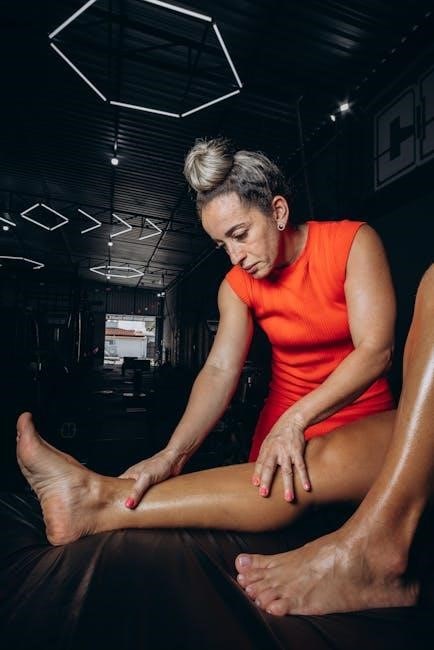Physical therapy leg strengthening exercises are essential for improving mobility, balance, and recovery. They target key muscle groups, enhancing overall lower limb function and reducing injury risk.
1.1 Importance of Leg Strength in Physical Therapy
Leg strength is critical for mobility, balance, and overall physical function. Strong legs support body stability, reduce injury risk, and enhance recovery post-surgery or injury. Physical therapy emphasizes leg strengthening to improve gait, posture, and daily activity performance. Weak leg muscles can lead to complications like knee pain or limited mobility, making targeted exercises essential for restoring independence and maintaining an active lifestyle.
1.2 Overview of Leg Strengthening Exercises
Leg strengthening exercises in physical therapy include a range of movements targeting specific muscle groups. From foundational exercises like straight leg raises and heel slides to intermediate and advanced routines such as squats and lunges, these activities are tailored to enhance strength, improve mobility, and support recovery. They are often customized to address individual needs, ensuring safe and effective progression for optimal outcomes.

Key Muscle Groups Targeted in Leg Strengthening
Quadriceps, hamstrings, calf muscles, glutes, and hip flexors are the primary muscle groups targeted in leg strengthening exercises to enhance stability, mobility, and overall lower limb function.
2.1 Quadriceps and Hamstrings
The quadriceps and hamstrings are crucial for knee stability and movement. Strengthening these muscles enhances flexibility, supports daily activities, and prevents injuries. Exercises like straight leg raises and heel slides target these groups, improving balance and reducing recovery time post-surgery or injury. A strong quadriceps-hamstring balance is vital for optimal lower limb function and overall mobility.
2.2 Calf Muscles (Gastrocnemius and Soleus)
The calf muscles, comprising the gastrocnemius and soleus, are vital for ankle mobility and lower leg stability. Strengthening these muscles through exercises like calf raises and heel slides enhances walking, running, and balance. Weakness in these areas can lead to injuries, making targeted exercises essential for rehabilitation and overall lower limb function in physical therapy programs.
2.3 Glutes and Hip Flexors
The glutes and hip flexors play a crucial role in hip stability, posture, and movement. Strengthening these muscles through exercises like squats, lunges, and bridges improves functional mobility and reduces injury risk. Weakness in this area can lead to poor posture and gait issues, making targeted exercises essential for overall lower limb strength and stability in physical therapy programs.
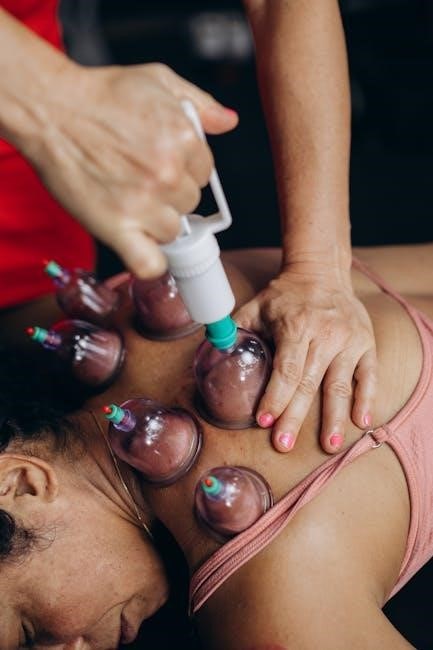
Benefits of Leg Strengthening Exercises in Physical Therapy
Leg strengthening exercises enhance mobility, accelerate recovery, and prevent injuries, promoting overall lower limb function and stability in physical therapy.
3.1 Improved Mobility and Balance
Strengthening leg muscles through physical therapy enhances mobility and balance by increasing muscle endurance and stability. This reduces the risk of falls and improves overall functional movement, making daily activities easier and safer for individuals recovering from injuries or surgeries, particularly in cases of knee or hip rehabilitation.
3.2 Enhanced Recovery Post-Surgery or Injury
Leg strengthening exercises play a vital role in post-surgery or injury recovery by restoring muscle function, improving joint stability, and promoting tissue repair. Consistent practice accelerates the return to normal activities and reduces the risk of future injuries, particularly for individuals recovering from knee or hip surgeries, as highlighted in resources like “The Best Leg Strengthening Exercises After Surgery” by Laura Inverarity.
3.3 Prevention of Future Injuries
Strengthening leg muscles helps prevent future injuries by improving joint stability and muscle balance. Exercises like calf raises and squats enhance the resilience of tendons and ligaments, reducing the risk of strains and tears. Regular practice, as outlined in “Physical Therapy Leg Strengthening Exercises,” supports long-term injury prevention, particularly for athletes and individuals with high physical activity levels.
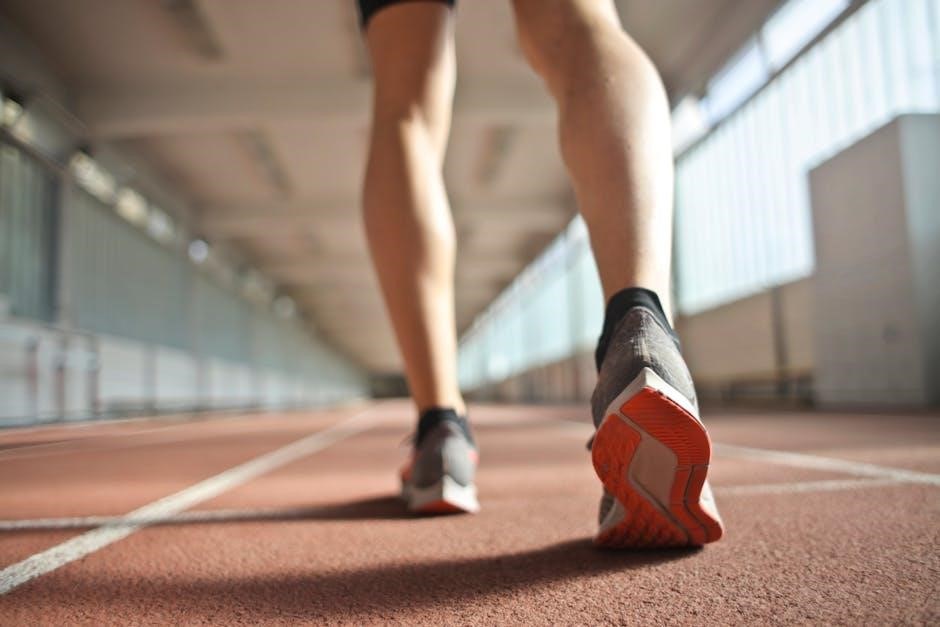
Foundational Leg Strengthening Exercises
Foundational exercises like straight leg raises and heel slides improve strength and mobility. They are essential for building a base for more advanced movements safely and effectively.
4.1 Straight Leg Raises
Straight leg raises strengthen the quadriceps without moving the knee. Lie on your back, tighten the thigh muscles, and lift one leg while keeping it straight. Hold for 5 seconds, then lower slowly. This exercise improves knee stability and strength, especially after surgery or injury, promoting proper healing and function.
4.2 Heel Slides
Heel slides are a foundational exercise that improves knee mobility and strengthens the quadriceps. Lie on your back, bend the affected knee, and slide your heel toward your buttocks. Hold for 5 seconds, then slowly return to the starting position. This exercise enhances flexibility and strength, ideal for post-surgery or injury recovery, promoting proper healing and functional movement.
4.3 Knee Extensions
Knee extensions target the quadriceps muscles, enhancing strength and stability. Sit or lie down, lift the leg straight while tightening the thigh muscles, and hold for 5 seconds. This exercise improves knee function, reduces pain, and is often recommended post-injury or surgery to restore mobility and support daily activities effectively.
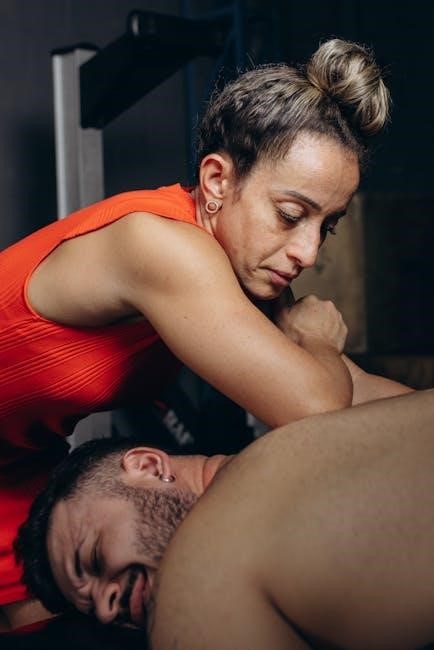
Intermediate Leg Strengthening Exercises
Intermediate exercises build on foundational movements, increasing intensity and complexity. They focus on improving strength, balance, and functional mobility, preparing for more advanced physical therapy routines.
5.1 Step-Ups
Step-ups are an intermediate exercise targeting the quadriceps, hamstrings, and glutes. Using a sturdy step or bench, step up with one leg, then the other, maintaining proper form.
Focus on controlled movements to avoid injury and maximize muscle engagement.
This exercise improves functional strength, balance, and coordination, making it ideal for progressing from foundational to more advanced leg-strengthening routines in physical therapy.
5.2 Mini Squats
Mini squats are an intermediate exercise that strengthens the quadriceps, hamstrings, and glutes. Performed with a partial range of motion, they are ideal for rebuilding strength post-injury or surgery.
Knees should track over toes, and the chest remains upright to maintain proper form.
Mini squats enhance stability, balance, and functional mobility, making them a versatile addition to physical therapy leg-strengthening programs.
5.3 Side-Lying Leg Lifts
Side-lying leg lifts target the hip abductors and glutes, improving pelvic alignment and balance. Lie on one side with legs straight, lift the top leg slowly, then lower it.
Perform 10-15 repetitions on each side to enhance hip strength and stability.
This exercise is ideal for intermediate levels and supports recovery by strengthening lateral hip muscles effectively.

Advanced Leg Strengthening Exercises
Advanced exercises like single-leg squats, calf raises on a step, and lunges build strength, balance, and functional movement. They target key muscles for improved performance and injury prevention.
6.1 Single-Leg Squats
Single-leg squats are an advanced exercise that improves balance, strength, and functional movement. Stand on one leg, bend the knee, and lower the body slightly, keeping the other foot lifted. Focus on proper form, engage the core, and maintain a straight back. This exercise enhances stability, promotes muscle activation, and mimics real-life movements, making it ideal for advanced physical therapy programs aimed at improving lower limb function and reducing injury risk.
6.2 Calf Raises on a Step
Calf raises on a step target the gastrocnemius and soleus muscles, enhancing ankle mobility and lower leg strength. Stand on a step with heels hanging off, raise onto tiptoes, then lower slowly. This exercise improves balance, reduces injury risk, and strengthens calf muscles. Progress by increasing step height or adding resistance. It’s ideal for advanced physical therapy to enhance functional strength and stability in the lower limbs.
6.3 Lunges
Lunges are an effective exercise for strengthening the quadriceps, hamstrings, glutes, and core muscles. Stand tall, step forward, and lower your body until both knees are bent at 90 degrees. Keep your back straight and front knee behind your toes. Push back to the starting position. Lunges improve balance, coordination, and functional strength, making them ideal for advanced physical therapy to enhance lower limb symmetry and mobility while reducing injury risk.
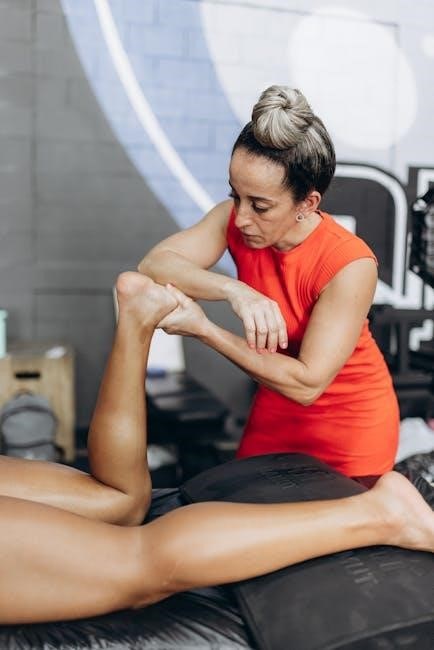
Leg Strengthening Exercises for Specific Needs
Leg strengthening exercises are tailored for post-surgery recovery, seniors, and sports-specific requirements, addressing individual needs to optimize strength, mobility, and function effectively.
7.1 Post-Surgery Recovery Exercises
Post-surgery recovery exercises focus on restoring strength and mobility in the legs. Gentle movements like straight leg raises and heel slides are often recommended to avoid stressing the surgical site. These exercises promote blood circulation, reduce stiffness, and gradually rebuild muscle tone. Progression is gradual, ensuring the body heals properly while regaining functional abilities safely and effectively.
7.2 Exercises for Seniors
Exercises for seniors focus on improving balance, strength, and flexibility. Gentle movements like seated leg extensions and ankle pumps are effective. Seated marching and wall-assisted squats are also beneficial, promoting mobility without strain. These exercises help prevent falls, enhance independence, and maintain functional abilities, ensuring seniors can perform daily tasks safely and confidently.
7.3 Sports-Specific Leg Strengthening
Sports-specific leg strengthening exercises are tailored to enhance performance and prevent injuries in athletes. For runners, exercises like single-leg squats and calf raises improve endurance. Soccer players benefit from plyometric lunges and step-ups. Strengthening the quadriceps and hamstrings is crucial for football and basketball athletes. Tailored programs help athletes maintain peak performance, reduce injury risks, and recover efficiently, ensuring optimal physical conditioning for their sport.
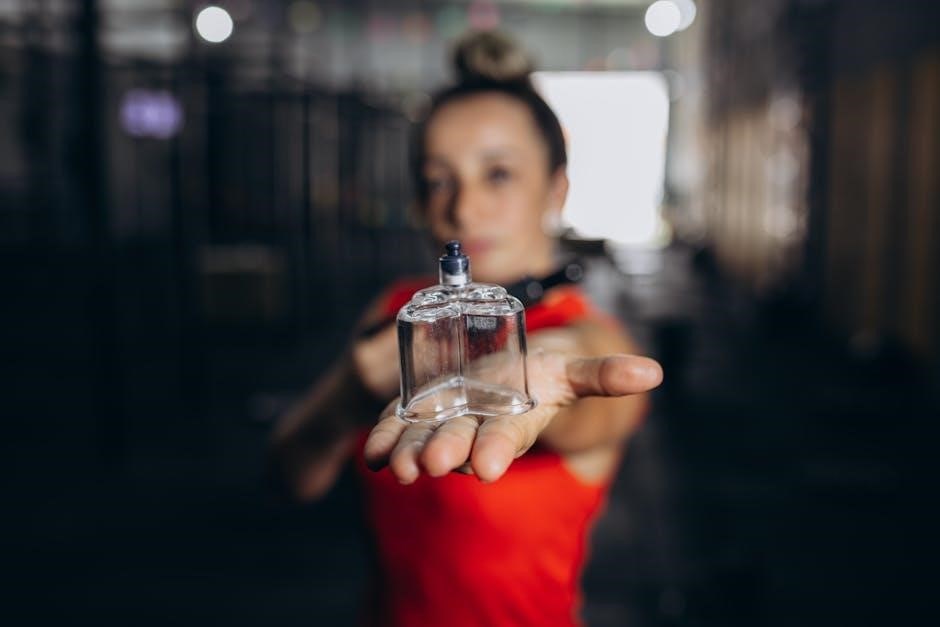
Progression of Exercises in Physical Therapy
Progression in physical therapy involves gradually increasing exercise resistance, enhancing range of motion, and building endurance to optimize recovery and strength over time effectively.
8.1 Increasing Resistance
In physical therapy, resistance is gradually increased to build strength. This can involve adding weights, using resistance bands, or progressing to more challenging exercises. For example, advancing from straight leg raises to weighted leg presses. Incorporating resistance enhances muscle activation and promotes functional improvements. Consistency and proper form are key to safely increase resistance levels and achieve optimal outcomes in leg strengthening programs.
8.2 Enhancing Range of Motion
Physical therapy often incorporates exercises to enhance range of motion, ensuring joints move freely and muscles function effectively. Straight leg raises and heel slides are common techniques to improve flexibility and reduce stiffness. These exercises promote better mobility, making daily activities easier and supporting overall lower limb function. Consistency and proper form are crucial to safely increase range of motion and maintain progress in leg strengthening programs.
8.3 Improving Endurance
Physical therapy programs often include exercises to boost leg endurance, ensuring prolonged activity without fatigue. Techniques like mini squats and seated marching are commonly used. These exercises enhance cardiovascular health and muscular stamina. Consistent practice, even for short durations, can significantly improve endurance levels. Supervised progression by a therapist ensures safety and effectiveness, leading to better mobility and reduced fatigue in daily activities and physical tasks.

Safety and Precautions
Ensuring proper form and avoiding overexertion are crucial. Tailoring exercises to individual needs prevents injuries and maximizes benefits, especially for post-surgery or vulnerable populations like seniors.
9.1 Proper Form and Technique
Maintaining proper form during leg strengthening exercises is vital to prevent injuries and ensure effectiveness. Techniques such as engaging core muscles, avoiding excessive strain, and following guided movements are emphasized. Therapists often demonstrate correct posture and alignment to maximize benefits and minimize risks, especially for individuals recovering from surgery or injuries.
9.2 Avoiding Overexertion
Avoiding overexertion is crucial to prevent muscle strain and setbacks. Patients should start with low-intensity exercises and gradually increase as strength improves. Listening to the body’s signals, such as pain or fatigue, ensures a safe progression. Overexertion can lead to injuries, delaying recovery and requiring additional therapy. Moderation and adherence to prescribed routines are key to effective and sustainable progress in leg strengthening programs.
9.3 Modifying Exercises for Individual Needs
Exercises must be tailored to individual needs, considering factors like injury severity, mobility, and strength levels. Modifications may include using supportive devices, reducing resistance, or adjusting movement ranges. For example, seniors or post-surgery patients might start with seated or assisted exercises. Customization ensures safety and effectiveness, promoting gradual progress without risking injury or discomfort. A physical therapist can guide appropriate adjustments for optimal outcomes.
Consistent practice of leg strengthening exercises is crucial for effective rehabilitation and overall lower limb health. Proper form and professional guidance ensure optimal results and injury prevention.
10.1 Summary of Key Points
Physical therapy leg strengthening exercises are vital for improving mobility, balance, and recovery. They target key muscle groups like quadriceps, hamstrings, and calves, enhancing overall lower limb function. Regular practice, proper form, and professional guidance ensure optimal results. These exercises are tailored to individual needs, aiding in post-surgery recovery, injury prevention, and long-term strength. Consistency and adherence to therapy plans are essential for achieving desired outcomes and maintaining muscle health.
10.2 Encouragement for Consistent Practice
Consistent practice of leg strengthening exercises is crucial for achieving long-term benefits. Patients are encouraged to stay motivated by tracking progress and celebrating small victories. Regular exercises improve mobility, reduce pain, and enhance overall quality of life. With commitment and proper guidance from physical therapists, individuals can overcome challenges and maintain strong, healthy legs for years to come.
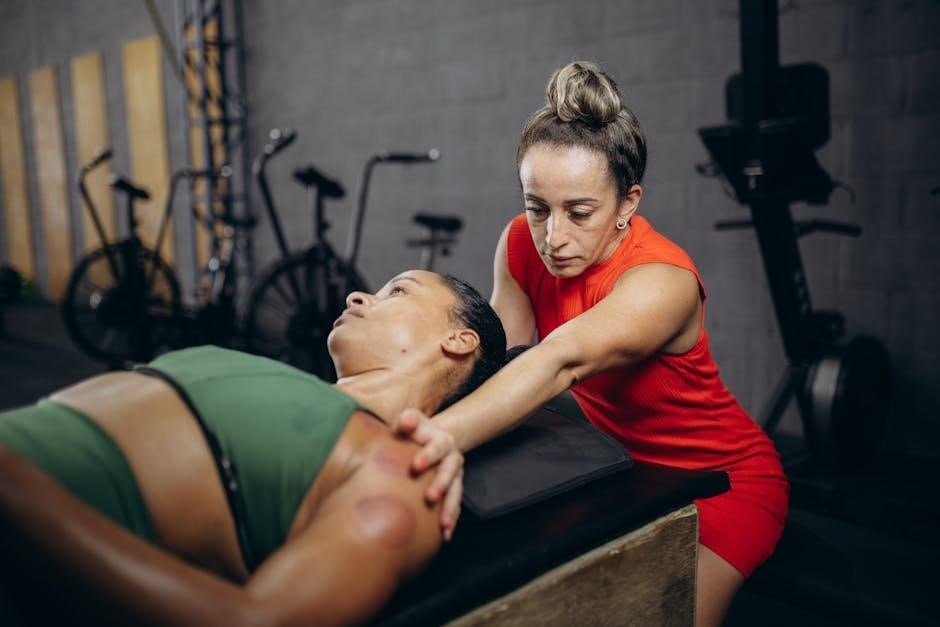
Additional Resources
Explore detailed PDF guides and online resources offering comprehensive leg strengthening exercises. Consultation with a physical therapist ensures personalized and effective treatment plans for optimal recovery.
11.1 Recommended PDF Guides
Downloadable PDF guides like Lower Extremity Exercise1.pdf and Lower Extremity Strengthening Cards provide detailed workout plans for leg strengthening. These resources, designed by physical therapy experts, include step-by-step instructions, diagrams, and progression tips tailored for various needs, such as post-surgery recovery or pediatric care. They are ideal for home use and complement professional guidance, ensuring safe and effective practice.
11.2 Online Communities and Forums
Joining online communities like physical therapy forums or social media groups can provide valuable support and resources. Platforms such as Facebook groups or specialized forums offer access to shared experiences, exercise tips, and expert advice. Many communities feature Q&A sessions with licensed therapists, exercise demos, and downloadable guides, fostering a supportive environment for individuals seeking to strengthen their legs effectively.
11.3 Consultation with a Physical Therapist
Consulting a licensed physical therapist ensures personalized guidance for leg strengthening. They create tailored exercise plans, monitor progress, and adjust routines based on individual needs and goals. Therapists also provide expert advice on proper form, injury prevention, and recovery strategies, making them an invaluable resource for effective and safe leg strengthening programs.
